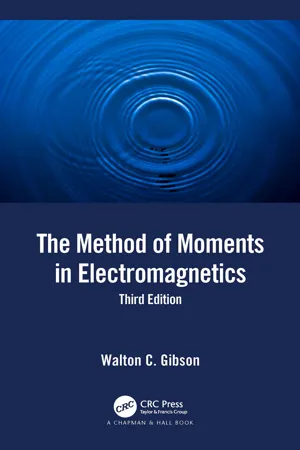
- 480 pages
- English
- ePUB (mobile friendly)
- Available on iOS & Android
The Method of Moments in Electromagnetics
About This Book
The Method of Moments in Electromagnetics, Third Edition details the numerical solution of electromagnetic integral equations via the Method of Moments (MoM). Previous editions focused on the solution of radiation and scattering problems involving conducting, dielectric, and composite objects. This new edition adds a significant amount of material on new, state-of-the art compressive techniques. Included are new chapters on the Adaptive Cross Approximation (ACA) and Multi-Level Adaptive Cross Approximation (MLACA), advanced algorithms that permit a direct solution of the MoM linear system via LU decomposition in compressed form. Significant attention is paid to parallel software implementation of these methods on traditional central processing units (CPUs) as well as new, high performance graphics processing units (GPUs). Existing material on the Fast Multipole Method (FMM) and Multi-Level Fast Multipole Algorithm (MLFMA) is also updated, blending in elements of the ACA algorithm to further reduce their memory demands.
The Method of Moments in Electromagnetics is intended for students, researchers, and industry experts working in the area of computational electromagnetics (CEM) and the MoM. Providing a bridge between theory and software implementation, the book incorporates significant background material, while presenting practical, nuts-and-bolts implementation details. It first derives a generalized set of surface integral equations used to treat electromagnetic radiation and scattering problems, for objects comprising conducting and dielectric regions. Subsequent chapters apply these integral equations for progressively more difficult problems such as thin wires, bodies of revolution, and two- and three-dimensional bodies. Radiation and scattering problems of many different types are considered, with numerical results compared against analytical theory as well as measurements.
Frequently asked questions
Information
Chapter 1
Computational Electromagnetics
1.1 CEM Algorithms
1.1.1 Low-Frequency Methods
1.1.1.1 Finite Difference Time Domain Method
1.1.1.2 Finite Element Method
1.1.1.3 Method of Moments
1.1.2 High-Frequency Methods
1.1.2.1 Geometrical Theory of Diffraction
1.1.2.2 Physical Optics
1.1.2.3 Physical Theory of Diffraction
1.1.2.4 Shooting and Bouncing Rays
References
- [1] D. E. Amos, “A subroutine package for Bessel functions of a complex argument and nonnegative order,” Tech. Rep. SAND85-1018, Sandia National Laboratory, May 1985.
- [2] A. Taflove and S. C. Hagness, Computational Electrodynamics: The Finite-Difference Time-Domain Method. Artech House, third ed., 2005.
- [3] K. Kunz and R. Luebbers, The Finite Difference Time Domain Method for Electromagnetics. CRC Press, 1993.
- [4] J. Jin, The Finite Element Method in Electromagnetics. John Wiley and Sons, 1993.
- [5] J. L. Volakis, A. Chatterjee, and L. C. Kempel, Finite Element Method for Electromagnetics. IEEE Press, 1998.
- [6] J. B. Keller, “Geometrical theory of diffraction,” J. Opt. Soc. Amer., vol. 52, pp. 116–130, February 1962.
- [7] R. G. Kouyoumjian and P. H. Pathak, “A uniform geometrical theory of diffraction for an edge in a perfectly conducting surface,” Proc. IEEE, vol. 62, pp. 1448–1461, November 1974.
- [8] C. A. Balanis, Advanced Engineering Electromagnetics. John Wiley and Sons, 1989.
- [9] P. Ufimtsev, “Approximate computation of the diffraction of plane electromagnetic waves at certain metal bodies (i and ii),” Sov. Phys. Tech., vol. 27, pp. 1708–1718, August 1957.
- [10] A. Michaeli, “Equivalent edge currents for arbitrary aspects of observation,” IEEE Trans. Antennas Propagat., vol. 23, pp. 252–258, March 1984.
- [11] H. Ling, S. W. Lee, and R. Chou, “Shooting and bouncing rays: calculating the RCS of an arbitrarily shaped cavity,” IEEE Trans. Antennas Propagat., vol. 37, pp. 194–205, February 1989.
- [12] H. Ling, S. W. Lee, and R. Chou, “High-frequency RCS of open cavities with rectangular and circular cross sections,” IEEE Trans. Antennas Propagat., vol. 37, pp. 648–652, May 1989.
Table of contents
- Cover
- Half Title
- Title Page
- Copyright Page
- Contents
- Preface to the Third Edition
- Preface to the Second Edition
- Preface
- Acknowledgments
- About the Author
- 1 Computational Electromagnetics
- 2 The Method of Moments
- 3 Radiation and Scattering
- 4 Solution of Matrix Equations
- 5 Thin Wires
- 6 Two-Dimensional Problems
- 7 Bodies of Revolution
- 8 Three-Dimensional Problems
- 9 Adaptive Cross Approximation
- 10 Multi-Level Adaptive Cross Approximation
- 11 The Fast Multipole Method
- 12 Integration
- A Scattering Using Physical Optics
- Index